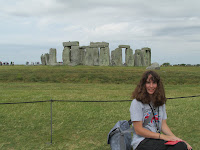 |
| A classic view of Stonehenge |
Despite forecasts that had predicted afternoon showers, we were able to escape most of the rain for the whole programme until it was time to get back on the coaches for the return trip to Exeter.
I was very excited to see Stonehenge. I didn't know all that much about this prehistoric monument prior to coming here, but after hearing so about it and seeing photographs all my life, it was quite an amazing experience to actually see it in person. A tour of Stonehenge includes an audio guide that explains various aspects of the monument at designated points. It was easy to use, though I had difficulty balancing the audio guide next to my ear whilst taking photographs of almost every conceivable angle of the stones. A circular path surrounds Stonehenge and there is a rope that prevents you from walking right up to the stones. I already knew that it would be like this before I even left the US, but I was pleasantly surprised to see that a section of the path actually gets quite close to the stones, closer than I thought it would.
I learned today that the bluestones used for Stonehenge were transported all the way from Wales! These smaller stones weigh up to 4 tons. The sarsens, or large stones, which often have lintels placed across the top, most likely came from around 20 miles away.
 |
| Stonehenge: World's largest bird perc |
 |
| The many angles of Stonehenge |
 |
| I'm having a bad hair day in this one |
Stonehenge today, is of course, incomplete, but that much of it is still standing is a testament to the engineering ingenuity of the builders. As nice and impressive as many of our modern buildings are, I don't think most of them will still be standing after 3,000 years!
Learn more about Stonehenge here: http://www.english-heritage.org.uk/daysout/properties/stonehenge/
After Stonehenge, we traveled a short distance to Salisbury, a small town that is renowned for its massive cathedral.
Before we walked to the famous cathedral, we stopped at a smaller medieval church to hear the end of a local concert that was played by a pianist, clarinetist, and violinist. It was pretty magical to hear such beautiful music played in an equally beautiful setting and it helped set the tone for the rest of the trip.
When we reached Salisbury Cathedral, built in the 13th century, we were impressed by the sheer size and beauty of this large church. In another amazing feat of primitive engineering, a spire that towers 404 feet above the ground was constructed in the 14th century by medieval builders, a height that is still fairly impressive today.
 |
| Outside of Salisbury Cathedral |
 |
| The cloisters. Seem familiar? |
 |
| Looking up at the spire |
No free man shall be seized or imprisoned, or stripped of his rights or possessions, or outlawed or exiled . nor will we proceed with force against him . except by the lawful judgement of his equals or by the law of the land. To no one will we sell, to no one deny or delay right or justice.
The Magna Carta essentially limited royal authority, quite an astounding feat since no one could limit royal authority at this time, except for the king himself (as you can imagine, the barons were quite persuasive in making this happen). Even if the people who drew up this document had no intention of extending universal rights to everyone, the Magna Carta inspired later generations to aspire to do just that.Seeing this document in person was amazing. Since there was no printing press at this time (early 13th century), everything had to be copied by hand, yet the letters are so perfectly blocked out and written, it almost looks as if it was done by a printing press!
The Magna Carta is written in a shorthand form of Latin, so it is extremely difficult for non-experts to read. However, Salisbury Cathedral provides an English translation of the document for those who are interested.
Learn more about Salisbury Cathedral and the Magna Carta here:
http://www.salisburycathedral.org.uk/index.php
I had a great time seeing such beautiful historic landmarks and artifacts today and I hope you enjoyed reading about them.
I am enjoying reading these Katelyn--some really interesting things! I actually enjoyed reading about the academics, but I suppose you're right that others may not. I wouldn't totally rule them out though...
ReplyDelete